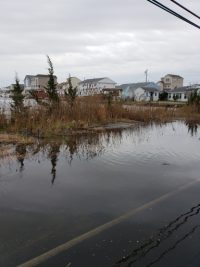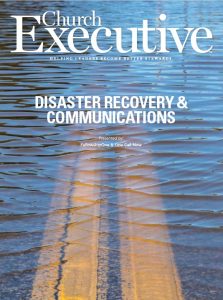
Practical expert advice for a scary subject
When using the term “disaster,” what types of events or circumstances are we referring to?
Hillary Keller Bowling: The most common disasters are weather-related events such as hurricanes, flooding, tornados and wildfires. Other disasters are arson, accidental fire, active-shooters, and even cybersecurity events.
Matthew McMaster: Every part of the country has the potential to be impacted: hurricanes on the East and Gulf coasts, fires and earthquakes on the West Coast, and tornados and flooding across the Midwest. Every part has the potential to be impacted by some type of disaster.
Are there certain types of disasters that are on the rise?

Program Manager
One Call Now
McMaster: According to the EM-DAT, an emergency disaster database maintained by the Office of US Foreign Disaster Assistance, the total natural disasters reported each year has steadily increased in recent decades. However, part of the increase could be due to advances in reporting and communication. Disasters are better tracked and certainly better communicated with the

Sr Professional
Services Consultant
FellowshipOne
acceleration of our 24-hour news cycle.
Keller Bowling: Unfortunately, we’ve seen violence on the rise in the church. Often, it’s a domestic dispute that pours over into the church environment; or, in some cases, the church is targeted because of its belief system. Violent incidents and resulting deaths at churches and other faith-based facilities increased dramatically a few years ago. In fact, with 118 deaths recorded in 2017 — the most recent year for which statistics are available — it was by far the most violent year faith-based organizations have experienced in American history.
According to the Deadly Force Incident study on violence in faith-based organizations across the United States, from January 1999 through December 2017, there were at least 1,705 violent incidents with deadly force potential.
Severe weather incidents and wildfires have also been on the rise. Over the past decade, scientists have observed a significant increase in the number of large fires and the total area burned each year in the United States. Hurricanes have also been wreaking havoc on the U.S. 2017 was the deadliest hurricane season we have seen since 2005.
Just this spring alone, we’ve seen an uptick in widespread tornado outbreaks sweeping across the Midwest and Plains.
Are most churches adequately prepared?
McMaster: No. Most churches are focused on immediate issues like needing more volunteers in the nursery, whether or not to expand the sanctuary, growing more disciples, and helping more people to know Christ. Amidst all this, the idea of some impending disaster might register, but it’s probably not the priority.
Keller Bowling: Unfortunately, most churches aren’t prepared for disaster.
Among churches that fall short in this area, what elements are most commonly missing?
McMaster: A plan! Having an emergency plan in place ensures you’re able to quickly and efficiently help those impacted. Without proper preparation, you risk exhausting your resources, responding inadequately, or — worst-case scenario — failing to respond at all.
When Hurricane Katrina hit, a church in Louisiana contacted me a week later and asked how they could recover their FellowshipOne database to start finding and communicating with their people. Because they hadn’t been proactive in disaster planning, they didn’t even realize FellowshipOne is a cloud-based software providing access anytime, anywhere, and on any device.
Keller Bowling: Many churches don’t have up-to-date contact information for the majority of their members. They also don’t have a way to get in touch quickly with the congregation. In case of an emergency, you can’t count on a manual phone tree to be enough to get your message out quickly and accurately.
What are the elements of an effective disaster recovery ministry / team?
Keller Bowling: If your church has a communications director, either on staff or as a volunteer, they’ll be a key member of the recovery ministry. The team should also include the church treasurer and a member of the pastoral team. Having at least these key roles on the recovery team will ensure the church’s vision and financial interests are protected and that the plan is communicated to the congregation in an effective manner.
McMaster: First and foremost, identify and recruit active members of the congregation with specific skills, such as medical, emergency response, law enforcement, facilities management, and volunteer coordination expertise. Your ChMS should make it easy to vet volunteers. Make sure there’s a link to seamless background checks included.
In addition, this recovery team needs a plan. Think through different scenarios. What do we do if a tornado hits our town? What do we do in case of a flood? Can we house people in the church? How do we empower our small groups as response teams?
Disaster recovery teams should familiarize themselves with federal, state and local data sources to determine the risks in any given area. This wealth of information includes declared disaster areas, flood inundation maps, ShakeMaps that track the aftermath of earthquakes, and more.
Retired people are great at leading disaster recovery ministry / teams. They have the time and are often looking for things to lead and get involved in. However, anyone with an interest can serve in this group. The best volunteers are those who are passionate about responding to people’s needs.
What strategies should a church adopt …
Now, before disaster strikes?

McMaster: Plan and invest. What equipment will be needed? If you’ll need chainsaws and construction equipment when a tornado hits, then have some on hand. If you’re in a hurricane-prone area, what’s your plan for housing people who can’t evacuate? How are you going to feed them? Evaluate the resources and the risks for disaster in your area and come up with a detailed response plan.
Use your website as a communications hub. For instance, if your region is prone to disasters, you can publish a plan on your website. This ensures your congregation members and the community are aware that you care and are prepared to assist.
Keller Bowling: Create an emergency response plan for the most common emergencies in your region. For example, if you’re in a flood zone, make sure you have a specific plan in place for flooding. But also create a general emergency plan for the unforeseen disasters. Train and communicate this plan to all staff and volunteers on a regular basis. The plan will fail if it isn’t well-known and practiced at regular intervals.
During a disaster?
Keller Bowling: Execute the plan and communicate consistently with the team but also the congregation. You can also use your mass notification service to communicate with sub-groups rather than the entire congregation. For example, you can divide your congregation into unlimited sub-groups. Some common groups would be: finance committee, facilities committee, pastoral staff, volunteers, youth ministry, and audio/visual team.
McMaster: Empower your church. Confusion abounds during a disaster — and rapid communications are key. Communicate with your congregation in real time and express needs that can be met. Your ChMS should contain a robust communications module that includes mass messaging by text, email and phone calls. During the crisis, this gets the word out about disasters, mobilizing volunteers, soliciting giving, sharing information about emergency services, and passing on crucial and timely information.
After a disaster?
Keller Bowling: Make any necessary insurance claims as soon as possible to avoid any delays in processing. Communicate regularly with your congregation. Ask for volunteers for clean-up, prayers and donations if needed. Let everyone know when and where services will be restored. No one likes being in the dark, and in a time of tragedy, many rely on their church. If the church is silent, they can be lost and feel helpless. Regular communication will keep the community strong, even if they can’t be in their place of worship together.
McMaster: Often, people are still homeless for months after a disaster. Insurance stays in a hotel can expire. Getting people connected to government agencies that offer disaster relief can be confusing or, worse, you have to do it online with no computer.
It’s important that the local church stay involved with those in the community needing help.
What advice can you offer regarding communication strategies, pre-disaster?
McMaster: Establish a communication plan for disaster, and then provide ongoing training on the plan. An emergency plan that hasn’t been trained on isn’t an emergency plan.
Keller Bowling: Purchase a mass notification system and get all staff trained on the system. Use the system regularly to reach the congregation so that senders and recipients are comfortable with the protocol. Create messages in case of common disasters, and store them so that in case of emergency they can be easily launched. Update all congregants’ contact information so that when disaster strikes you can reach all stake holders.
During the event?
Keller Bowling: Stay calm. Launch a message as soon as it’s safe to do so, letting the congregation know of the current situation and what they can do to help. Continue to communicate to keep everyone in the loop and build trust and engagement with your members.
McMaster: Don’t be afraid to over communicate. People need to be apprised of the current situation. Often, it changes with the hour. The response needs to be quick and decisive.
After the event?
McMaster: Keep your congregation and volunteers focused on long-term care. Form small groups to help people cope with the loss of life or property.
Keller Bowling: Message the congregation with an update on the situation. Thank members for their help and support during the crisis. Request volunteers and donations, if needed, to recover from the disaster. Audit the emergency plan and how the team performed. Look for ways to improve the plan for the future. Continue to practice the plan regularly and train your team on all tools available.
What communication tools are available?
Keller Bowling: Mass notification tools like One Call Now should be in place for regular communication. Having a system in use regularly will ensure users are trained on using the system, are comfortable with the system, and can even save messages in the system to send in case of emergency.
McMaster: With FellowshipOne Premier, we have a process defined and documented that shows churches how to use our small groups tool during a disaster to find people with needs and pair them up with people who can meet those needs.
When should these tools be acquired?
McMaster: It’s critical that you acquire the tools to deal with natural disaster immediately. Waiting until you have a need or crisis
is irresponsible.
Keller Bowling: Now. No one plans on a disaster.
Who should be trained to use them?
Keller Bowling: All church leaders/staff should be trained to use them, because in case of an emergency you don’t want just one or two people trained only to find they’re unreachable or unavailable to communicate during the disaster.
McMaster: You need multiple people trained. Key volunteers need backups. What would happen if disaster struck and your disaster team lead was out of the country? Overprepare by training a larger team than you think you’ll need.
What is the typical learning curve for these tools?
McMaster: Learning how to use communication tools within FellowshipOne church takes 10 minutes. But you also need ongoing training sessions, so that people are reminded how to respond in a timely manner.
Keller Bowling: Most people can learn a system like One Call Now in less than an hour. You can purchase, load your contact information, and be using it all in the same day.
Remember: keeping the contact list up to date is the most important part of any communication plan.
— Reporting by RaeAnn Slaybaugh



This article references communicate or communication, 23 times! Do you get how important communication is? With 2way radios, you have the ability to communicate with staff and security personnel over a private network that works even when cell phones and power go down! If you’re not using 2way radios, you’re behind the power curve when it comes to emergency communication!